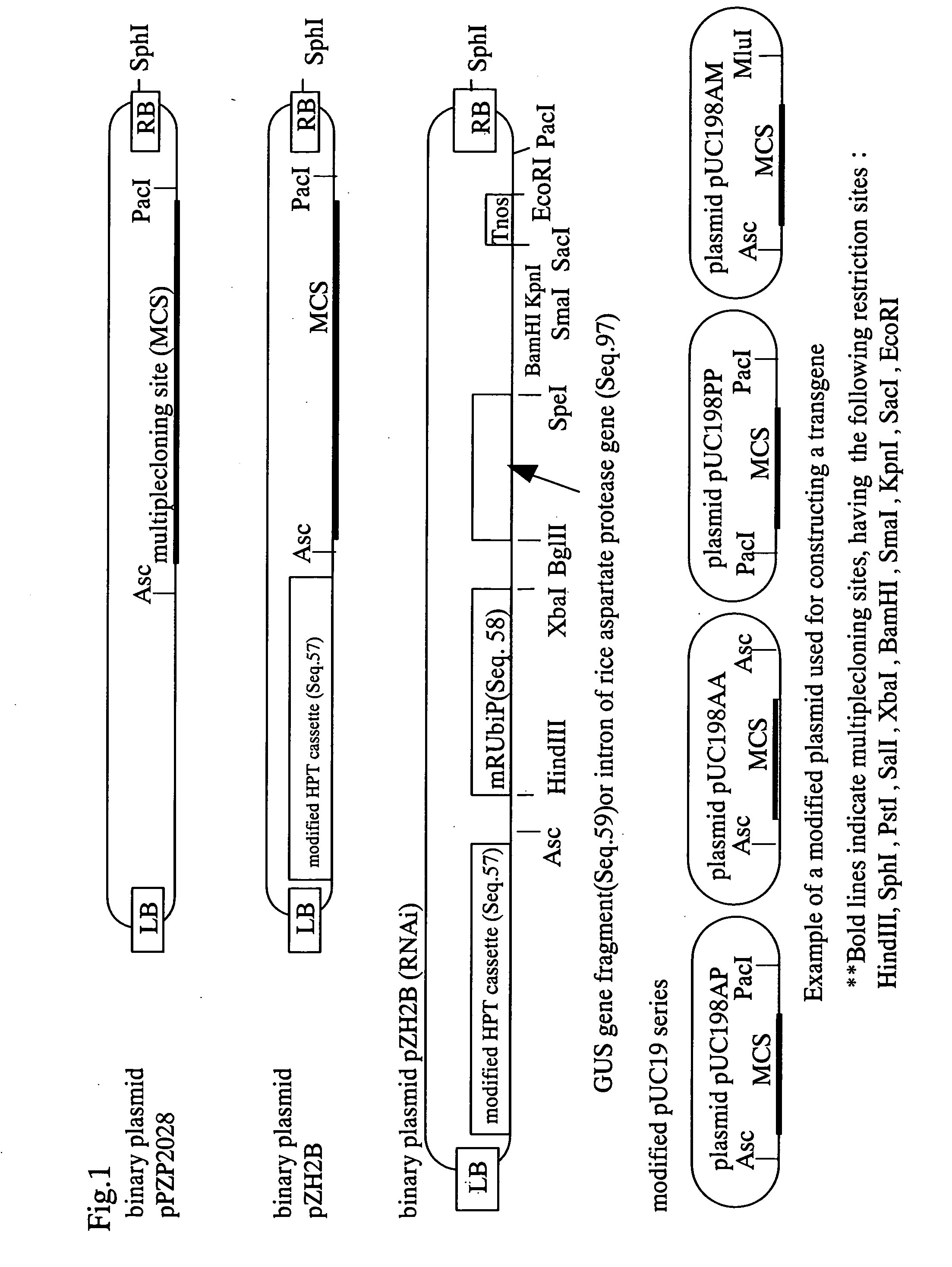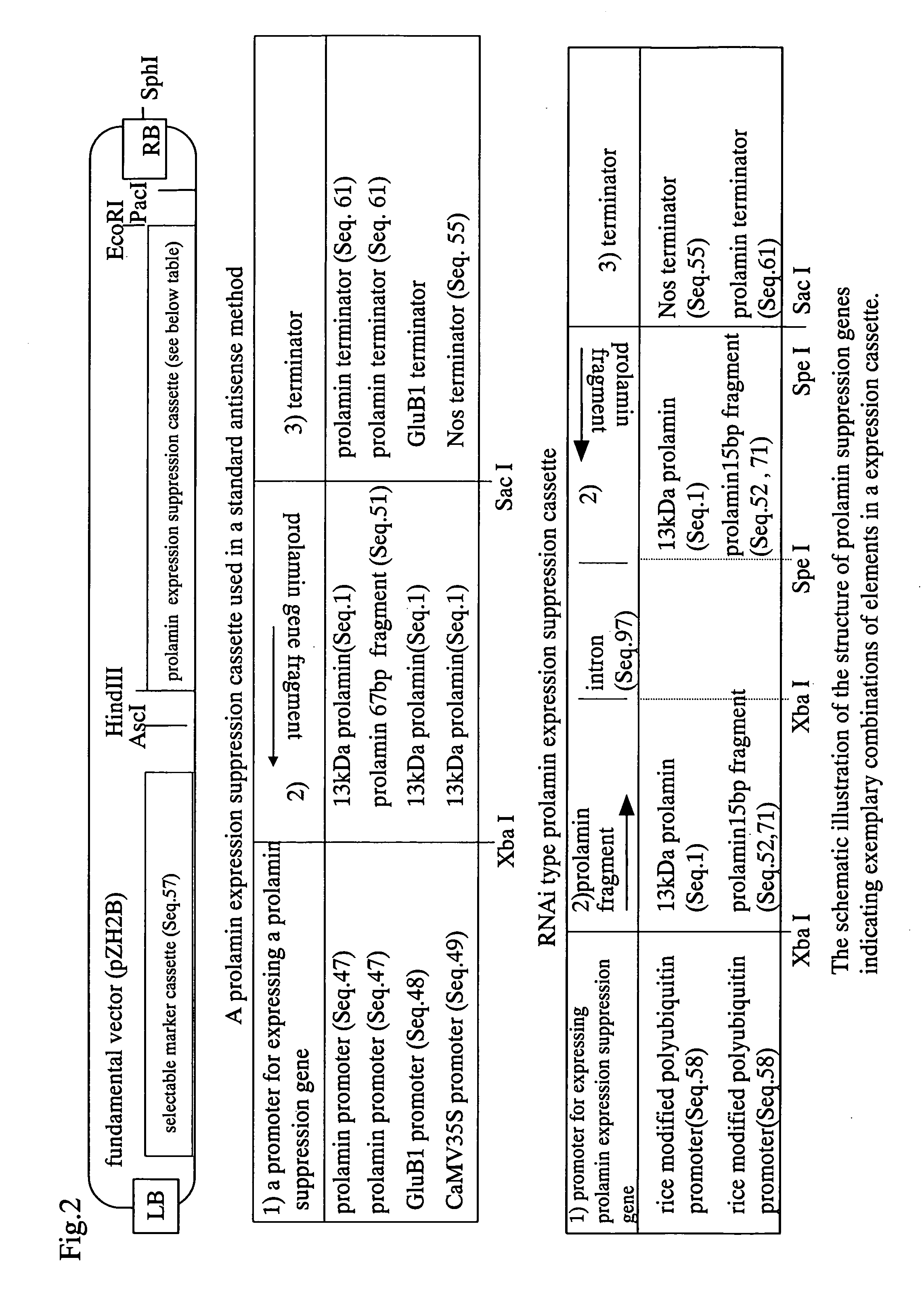Plant With Reduced Protein Content in Seed, Method of Constructing the Same and Method of Using the Same
- Summary
- Abstract
- Description
- Claims
- Application Information
AI Technical Summary
Benefits of technology
Problems solved by technology
Method used
Image
Examples
example 1
Production of Antisense Constructs
[0242]In the present Example, antisense constructs comprising antisense sequences as shown below, and promoters as shown below provide exemplifications of the present invention. Hereinafter, unless otherwise indicated, an antisense construct for reducing prolamin is collectively called “LP gene” or “LP cassette”, and a recombinant rice lineage with the same introduced, is collectively called “LP lineage”, and a lineage with reduced 13 kDa prolamin, the most abundant prolamin, content, is collectively called “LP13K lineage”. For a variant for which a gene is transduced, Nipponbare is represented as H, LGC-1 is represented as LG, and the other variants are represented as such. For example, “H-LP13K” refers to a “Nipponbare with prolamin reduced by the introduction of the LP gene”.
Promoter Sequences:
Rice 10 kDa prolamin gene derived sequence (SEQ ID NO: 470;
Rice glutelin B1 gene derived sequence (SEQ ID NO: 48)
CaMV 35S gene derived sequence (SEQ ID NO:...
example 2
Transformation of Rice with an Antisense Construct
[0251]A vector comprising the antisense construct as produced in Example 1 was used to transform two rice variants (Nipponbare and LGC-1) to produce transgenic rice. Nipponbare was used as a typical variant of rice. LGC-1 was used for more clearly confirming the effects of the present invention on prolamin, which is a rice modified by radiation of Nihonmasari, wherein glutelin expression is greatly decreased and prolamin expression is increased in the seed.
[0252]The specific procedure therefor is as follows:
[0253]Each of the antisense prolamin gene expression vectors shown in FIG. 2 were subjected to electroporation with Agrobacterium EHA101, and selection of bacteria possessing the vector performed using LB agar medium comprising 100 mg / L spectinomycin. Prior to Agrobacterium infection, the method of Raineri (Raineri D M., Bio / Technology 8, 33-38, 1990) has been used with a partial modification, and after the infection, the culture ...
example 3
Growth of Transformants
[0256]Commercially available compost (Honensu compost containing trace amounts of nutrition) was put into plastic pots (diameter: 15 cm), and rice, which was grown in a hormone-free medium for one month, was transferred thereto. Usually, seeds were located under natural light in a separate, isolated green house for sprouting seeds. As necessary, the seeds were placed in an artificial climate chamber (Nihon ika FH 301 or the like), cycles of 16-hour light period (15,000 lux or more, 30° C.)—eight-hour dark period (25° C.) were used for growth for two months, followed by cycles of 12-hour light period (15,000 lux or more, 30° C.)—12-hour dark period (25° C.) for two to three months to set seeds.
PUM
| Property | Measurement | Unit |
|---|---|---|
| Fraction | aaaaa | aaaaa |
| Atomic weight | aaaaa | aaaaa |
| Fraction | aaaaa | aaaaa |
Abstract
Description
Claims
Application Information
 Login to View More
Login to View More - R&D
- Intellectual Property
- Life Sciences
- Materials
- Tech Scout
- Unparalleled Data Quality
- Higher Quality Content
- 60% Fewer Hallucinations
Browse by: Latest US Patents, China's latest patents, Technical Efficacy Thesaurus, Application Domain, Technology Topic, Popular Technical Reports.
© 2025 PatSnap. All rights reserved.Legal|Privacy policy|Modern Slavery Act Transparency Statement|Sitemap|About US| Contact US: help@patsnap.com



